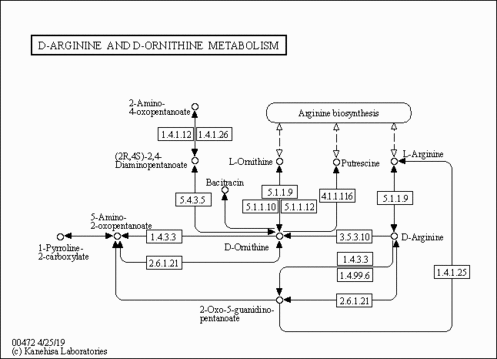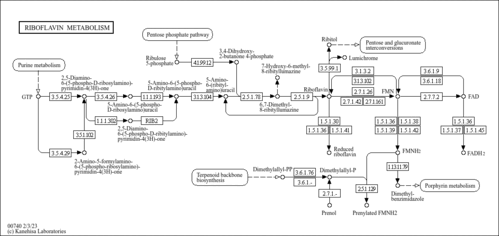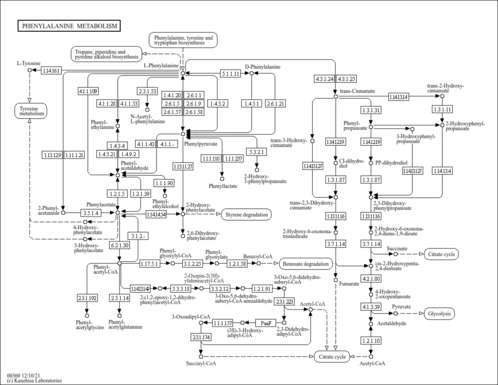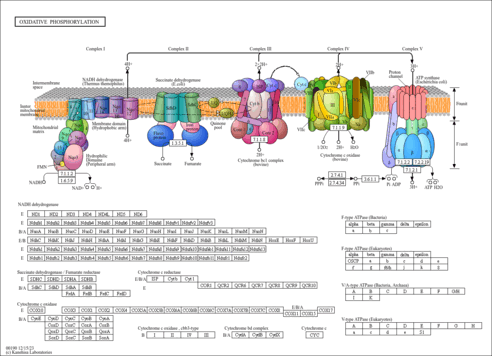| General References | - Carrier M, Denault A, Lavoie J, Perrault LP: Randomized controlled trial of pericardial blood processing with a cell-saving device on neurologic markers in elderly patients undergoing coronary artery bypass graft surgery. Ann Thorac Surg. 2006 Jul;82(1):51-5. [PubMed:16798186 ]
- Valadka AB, Furuya Y, Hlatky R, Robertson CS: Global and regional techniques for monitoring cerebral oxidative metabolism after severe traumatic brain injury. Neurosurg Focus. 2000 Nov 15;9(5):e3. [PubMed:16821755 ]
- Armonda RA, Vo AH, Bell R, Neal C, Campbell WW: Multimodal monitoring during emergency hemicraniectomy for vein of Labbe thrombosis. Neurocrit Care. 2006;4(3):241-4. [PubMed:16757831 ]
- Sassaroli A, deB Frederick B, Tong Y, Renshaw PF, Fantini S: Spatially weighted BOLD signal for comparison of functional magnetic resonance imaging and near-infrared imaging of the brain. Neuroimage. 2006 Nov 1;33(2):505-14. Epub 2006 Aug 30. [PubMed:16945553 ]
- Zhang YT, Geng ZJ, Zhang Q, Li W, Zhang J: Auditory cortical responses evoked by pure tones in healthy and sensorineural hearing loss subjects: functional MRI and magnetoencephalography. Chin Med J (Engl). 2006 Sep 20;119(18):1548-54. [PubMed:16996009 ]
- Ketcham EM, Cairns CB: Hemoglobin-based oxygen carriers: development and clinical potential. Ann Emerg Med. 1999 Mar;33(3):326-37. [PubMed:10036348 ]
- Capelli-Schellpfeffer M, Gerber GS: The use of hyperbaric oxygen in urology. J Urol. 1999 Sep;162(3 Pt 1):647-54. [PubMed:10458334 ]
- Weaver LK, Howe S, Hopkins R, Chan KJ: Carboxyhemoglobin half-life in carbon monoxide-poisoned patients treated with 100% oxygen at atmospheric pressure. Chest. 2000 Mar;117(3):801-8. [PubMed:10713010 ]
- Rooth G: Transcutaneous oxygen tension measurements in newborn infants. Pediatrics. 1975 Feb;55(2):232-5. [PubMed:1090895 ]
- Nath KA, Norby SM: Reactive oxygen species and acute renal failure. Am J Med. 2000 Dec 1;109(8):665-78. [PubMed:11099687 ]
- Kotecha S, Allen J: Oxygen therapy for infants with chronic lung disease. Arch Dis Child Fetal Neonatal Ed. 2002 Jul;87(1):F11-4. [PubMed:12091281 ]
- Van Heerebeek L, Meischl C, Stooker W, Meijer CJ, Niessen HW, Roos D: NADPH oxidase(s): new source(s) of reactive oxygen species in the vascular system? J Clin Pathol. 2002 Aug;55(8):561-8. [PubMed:12147646 ]
- Forman HJ, Torres M: Reactive oxygen species and cell signaling: respiratory burst in macrophage signaling. Am J Respir Crit Care Med. 2002 Dec 15;166(12 Pt 2):S4-8. [PubMed:12471082 ]
- Kemp PJ, Lewis A, Hartness ME, Searle GJ, Miller P, O'Kelly I, Peers C: Airway chemotransduction: from oxygen sensor to cellular effector. Am J Respir Crit Care Med. 2002 Dec 15;166(12 Pt 2):S17-24. [PubMed:12471084 ]
- Frey B, Shann F: Oxygen administration in infants. Arch Dis Child Fetal Neonatal Ed. 2003 Mar;88(2):F84-8. [PubMed:12598492 ]
- Wang C, Schwaitzberg S, Berliner E, Zarin DA, Lau J: Hyperbaric oxygen for treating wounds: a systematic review of the literature. Arch Surg. 2003 Mar;138(3):272-9; discussion 280. [PubMed:12611573 ]
- Ho AM, Lee A, Karmakar MK, Dion PW, Chung DC, Contardi LH: Heliox vs air-oxygen mixtures for the treatment of patients with acute asthma: a systematic overview. Chest. 2003 Mar;123(3):882-90. [PubMed:12628892 ]
- Rodrigo GJ, Rodrigo C, Pollack CV, Rowe B: Use of helium-oxygen mixtures in the treatment of acute asthma: a systematic review. Chest. 2003 Mar;123(3):891-6. [PubMed:12628893 ]
- Wangsa-Wirawan ND, Linsenmeier RA: Retinal oxygen: fundamental and clinical aspects. Arch Ophthalmol. 2003 Apr;121(4):547-57. [PubMed:12695252 ]
- Cohn SM: Oxygen therapeutics in trauma and surgery. J Trauma. 2003 May;54(5 Suppl):S193-8. [PubMed:12768124 ]
- Gordillo GM, Sen CK: Revisiting the essential role of oxygen in wound healing. Am J Surg. 2003 Sep;186(3):259-63. [PubMed:12946829 ]
- Deedwania PC, Carbajal EV: Role of myocardial oxygen demand in the pathogenesis of silent ischemia during daily life. Am J Cardiol. 1992 Nov 16;70(16):19F-24F. [PubMed:1442597 ]
- Listello D, Glauser F: COPD: primary care management with drug and oxygen therapies. Geriatrics. 1992 Dec;47(12):28-30, 35-8. [PubMed:1446842 ]
- McDonagh M, Helfand M, Carson S, Russman BS: Hyperbaric oxygen therapy for traumatic brain injury: a systematic review of the evidence. Arch Phys Med Rehabil. 2004 Jul;85(7):1198-204. [PubMed:15241774 ]
- Davis PG, Tan A, O'Donnell CP, Schulze A: Resuscitation of newborn infants with 100% oxygen or air: a systematic review and meta-analysis. Lancet. 2004 Oct 9-15;364(9442):1329-33. [PubMed:15474135 ]
- Roeckl-Wiedmann I, Bennett M, Kranke P: Systematic review of hyperbaric oxygen in the management of chronic wounds. Br J Surg. 2005 Jan;92(1):24-32. [PubMed:15635604 ]
- Goldstein BJ, Mahadev K, Wu X: Redox paradox: insulin action is facilitated by insulin-stimulated reactive oxygen species with multiple potential signaling targets. Diabetes. 2005 Feb;54(2):311-21. [PubMed:15677487 ]
- Giordano FJ: Oxygen, oxidative stress, hypoxia, and heart failure. J Clin Invest. 2005 Mar;115(3):500-8. [PubMed:15765131 ]
- Jallali N, Withey S, Butler PE: Hyperbaric oxygen as adjuvant therapy in the management of necrotizing fasciitis. Am J Surg. 2005 Apr;189(4):462-6. [PubMed:15820462 ]
- Domachevsky L, Adir Y, Grupper M, Keynan Y, Bentur Y: Hyperbaric oxygen in the treatment of carbon monoxide poisoning. Clin Toxicol (Phila). 2005;43(3):181-8. [PubMed:15902792 ]
- Burkhoff D, Lefer DJ: Cardioprotection before revascularization in ischemic myocardial injury and the potential role of hemoglobin-based oxygen carriers. Am Heart J. 2005 Apr;149(4):573-9. [PubMed:15990736 ]
- Glazier JJ: Attenuation of reperfusion microvascular ischemia by aqueous oxygen: experimental and clinical observations. Am Heart J. 2005 Apr;149(4):580-4. [PubMed:15990737 ]
- Kevin LG, Novalija E, Stowe DF: Reactive oxygen species as mediators of cardiac injury and protection: the relevance to anesthesia practice. Anesth Analg. 2005 Nov;101(5):1275-87. [PubMed:16243980 ]
- Bennett M, Kertesz T, Yeung P: Hyperbaric oxygen therapy for idiopathic sudden sensorineural hearing loss and tinnitus: a systematic review of randomized controlled trials. J Laryngol Otol. 2005 Oct;119(10):791-8. [PubMed:16259656 ]
- Levy MM: Pathophysiology of oxygen delivery in respiratory failure. Chest. 2005 Nov;128(5 Suppl 2):547S-553S. [PubMed:16306052 ]
- Huang YC: Monitoring oxygen delivery in the critically ill. Chest. 2005 Nov;128(5 Suppl 2):554S-560S. [PubMed:16306053 ]
- Liu Z, Xiong T, Meads C: Clinical effectiveness of treatment with hyperbaric oxygen for neonatal hypoxic-ischaemic encephalopathy: systematic review of Chinese literature. BMJ. 2006 Aug 19;333(7564):374. Epub 2006 May 11. [PubMed:16690641 ]
- Friedman HI, Fitzmaurice M, Lefaivre JF, Vecchiolla T, Clarke D: An evidence-based appraisal of the use of hyperbaric oxygen on flaps and grafts. Plast Reconstr Surg. 2006 Jun;117(7 Suppl):175S-190S; discussion 191S-192S. [PubMed:16799386 ]
- Terashvili M, Pratt PF, Gebremedhin D, Narayanan J, Harder DR: Reactive oxygen species cerebral autoregulation in health and disease. Pediatr Clin North Am. 2006 Oct;53(5):1029-37, xi. [PubMed:17027622 ]
- Colebourn CL, Barber V, Young JD: Use of helium-oxygen mixture in adult patients presenting with exacerbations of asthma and chronic obstructive pulmonary disease: a systematic review. Anaesthesia. 2007 Jan;62(1):34-42. [PubMed:17156225 ]
- Bradley JM, Lasserson T, Elborn S, Macmahon J, O'neill B: A systematic review of randomized controlled trials examining the short-term benefit of ambulatory oxygen in COPD. Chest. 2007 Jan;131(1):278-85. [PubMed:17218587 ]
- Tin W, Gupta S: Optimum oxygen therapy in preterm babies. Arch Dis Child Fetal Neonatal Ed. 2007 Mar;92(2):F143-7. [PubMed:17337663 ]
- Higgins RD, Bancalari E, Willinger M, Raju TN: Executive summary of the workshop on oxygen in neonatal therapies: controversies and opportunities for research. Pediatrics. 2007 Apr;119(4):790-6. [PubMed:17403851 ]
- Ness PM, Cushing MM: Oxygen therapeutics: pursuit of an alternative to the donor red blood cell. Arch Pathol Lab Med. 2007 May;131(5):734-41. [PubMed:17488158 ]
- Shelley KH: Photoplethysmography: beyond the calculation of arterial oxygen saturation and heart rate. Anesth Analg. 2007 Dec;105(6 Suppl):S31-6, tables of contents. [PubMed:18048895 ]
- Claure N: Automated regulation of inspired oxygen in preterm infants: oxygenation stability and clinician workload. Anesth Analg. 2007 Dec;105(6 Suppl):S37-41. [PubMed:18048896 ]
- Toffaletti J, Zijlstra WG: Misconceptions in reporting oxygen saturation. Anesth Analg. 2007 Dec;105(6 Suppl):S5-9. [PubMed:18048899 ]
- Ferrari R, Ceconi C, Curello S, Cargnoni A, Pasini E, De Giuli F, Albertini A: Role of oxygen free radicals in ischemic and reperfused myocardium. Am J Clin Nutr. 1991 Jan;53(1 Suppl):215S-222S. [PubMed:1845919 ]
- Kindwall EP, Gottlieb LJ, Larson DL: Hyperbaric oxygen therapy in plastic surgery: a review article. Plast Reconstr Surg. 1991 Nov;88(5):898-908. [PubMed:1924583 ]
- Cain SM, Curtis SE: Experimental models of pathologic oxygen supply dependency. Crit Care Med. 1991 May;19(5):603-12. [PubMed:2026022 ]
- Weg JG: Oxygen transport in adult respiratory distress syndrome and other acute circulatory problems: relationship of oxygen delivery and oxygen consumption. Crit Care Med. 1991 May;19(5):650-7. [PubMed:2026027 ]
- Edwards JD: Oxygen transport in cardiogenic and septic shock. Crit Care Med. 1991 May;19(5):658-63. [PubMed:2026028 ]
- Tuchschmidt J, Oblitas D, Fried JC: Oxygen consumption in sepsis and septic shock. Crit Care Med. 1991 May;19(5):664-71. [PubMed:2026029 ]
- Reilly PM, Schiller HJ, Bulkley GB: Pharmacologic approach to tissue injury mediated by free radicals and other reactive oxygen metabolites. Am J Surg. 1991 Apr;161(4):488-503. [PubMed:2035771 ]
- Burton GG, Wagshul FA, Henderson D, Kime SW: Fatal airway obstruction caused by a mucous ball from a transtracheal oxygen catheter. Chest. 1991 Jun;99(6):1520-3. [PubMed:2036843 ]
- McCord JM, Fridovich I: The biology and pathology of oxygen radicals. Ann Intern Med. 1978 Jul;89(1):122-7. [PubMed:208444 ]
- Ardehali A, Ports TA: Myocardial oxygen supply and demand. Chest. 1990 Sep;98(3):699-705. [PubMed:2203620 ]
- Edwards JD: Practical application of oxygen transport principles. Crit Care Med. 1990 Jan;18(1 Pt 2):S45-8. [PubMed:2403513 ]
- Kloner RA, Przyklenk K, Whittaker P: Deleterious effects of oxygen radicals in ischemia/reperfusion. Resolved and unresolved issues. Circulation. 1989 Nov;80(5):1115-27. [PubMed:2553296 ]
- Dart RC, Sanders AB: Oxygen free radicals and myocardial reperfusion injury. Ann Emerg Med. 1988 Jan;17(1):53-8. [PubMed:3276245 ]
- Cross CE, Halliwell B, Borish ET, Pryor WA, Ames BN, Saul RL, McCord JM, Harman D: Oxygen radicals and human disease. Ann Intern Med. 1987 Oct;107(4):526-45. [PubMed:3307585 ]
- Gabb G, Robin ED: Hyperbaric oxygen. A therapy in search of diseases. Chest. 1987 Dec;92(6):1074-82. [PubMed:3315479 ]
- Jackson RM: Pulmonary oxygen toxicity. Chest. 1985 Dec;88(6):900-5. [PubMed:3905287 ]
- Vik-Mo H, Mjos OD: Influence of free fatty acids on myocardial oxygen consumption and ischemic injury. Am J Cardiol. 1981 Aug;48(2):361-5. [PubMed:6115579 ]
- Klebanoff SJ: Oxygen metabolism and the toxic properties of phagocytes. Ann Intern Med. 1980 Sep;93(3):480-9. [PubMed:6254418 ]
- Tinits P: Oxygen therapy and oxygen toxicity. Ann Emerg Med. 1983 May;12(5):321-8. [PubMed:6414343 ]
- Lucey JF, Dangman B: A reexamination of the role of oxygen in retrolental fibroplasia. Pediatrics. 1984 Jan;73(1):82-96. [PubMed:6419199 ]
- Riley DJ, Berg RA, Edelman NH, Prockop DJ: Prevention of collagen deposition following pulmonary oxygen toxicity in the rat by cis-4-hydroxy-L-proline. J Clin Invest. 1980 Mar;65(3):643-51. [PubMed:6986411 ]
- DeVenuto F: Hemoglobin solutions as oxygen-delivering resuscitation fluids. Crit Care Med. 1982 Apr;10(4):238-45. [PubMed:7039970 ]
- Vlessis AA, Goldman RK, Trunkey DD: New concepts in the pathophysiology of oxygen metabolism during sepsis. Br J Surg. 1995 Jul;82(7):870-6. [PubMed:7648095 ]
- Seger D, Welch L: Carbon monoxide controversies: neuropsychologic testing, mechanism of toxicity, and hyperbaric oxygen. Ann Emerg Med. 1994 Aug;24(2):242-8. [PubMed:8037390 ]
- Frei B: Reactive oxygen species and antioxidant vitamins: mechanisms of action. Am J Med. 1994 Sep 26;97(3A):5S-13S; discussion 22S-28S. [PubMed:8085584 ]
- Jeroudi MO, Hartley CJ, Bolli R: Myocardial reperfusion injury: role of oxygen radicals and potential therapy with antioxidants. Am J Cardiol. 1994 Mar 10;73(6):2B-7B. [PubMed:8141076 ]
- Spahn DR, Leone BJ, Reves JG, Pasch T: Cardiovascular and coronary physiology of acute isovolemic hemodilution: a review of nonoxygen-carrying and oxygen-carrying solutions. Anesth Analg. 1994 May;78(5):1000-21. [PubMed:8160966 ]
- Helfman T, Falanga V: Gene expression in low oxygen tension. Am J Med Sci. 1993 Jul;306(1):37-41. [PubMed:8328508 ]
- Rudge FW: Carbon monoxide poisoning in infants: treatment with hyperbaric oxygen. South Med J. 1993 Mar;86(3):334-7. [PubMed:8451675 ]
- Ackerman WE 3rd, Molnar JM, Juneja MM: Beneficial effect of epidural anesthesia on oxygen consumption in a parturient with adult respiratory distress syndrome. South Med J. 1993 Mar;86(3):361-4. [PubMed:8451680 ]
- Haapaniemi T, Nylander G, Sirsjo A, Larsson J: Hyperbaric oxygen reduces ischemia-induced skeletal muscle injury. Plast Reconstr Surg. 1996 Mar;97(3):602-7; discussion 608-9. [PubMed:8596792 ]
- Heyland DK, Cook DJ, King D, Kernerman P, Brun-Buisson C: Maximizing oxygen delivery in critically ill patients: a methodologic appraisal of the evidence. Crit Care Med. 1996 Mar;24(3):517-24. [PubMed:8625644 ]
- Kerr ME, Bender CM, Monti EJ: An introduction to oxygen free radicals. Heart Lung. 1996 May-Jun;25(3):200-9; quiz 210-1. [PubMed:8635921 ]
- O'Donohue WJ Jr: Home oxygen therapy. Med Clin North Am. 1996 May;80(3):611-22. [PubMed:8637306 ]
- Cornwell EE 3rd, Kennedy F, Rodriguez J: The critical care of the severely injured patient--I. Assessing and improving oxygen delivery. Surg Clin North Am. 1996 Aug;76(4):959-69. [PubMed:8782482 ]
- Powell JF, Menon DK, Jones JG: The effects of hypoxaemia and recommendations for postoperative oxygen therapy. Anaesthesia. 1996 Aug;51(8):769-72. [PubMed:8795322 ]
- Dean E: Oxygen transport deficits in systemic disease and implications for physical therapy. Phys Ther. 1997 Feb;77(2):187-202. [PubMed:9037219 ]
- Feuerstein G, Yue TL, Ma X, Ruffolo RR: Novel mechanisms in the treatment of heart failure: inhibition of oxygen radicals and apoptosis by carvedilol. Prog Cardiovasc Dis. 1998 Jul-Aug;41(1 Suppl 1):17-24. [PubMed:9715819 ]
- Naito Y, Yoshikawa T, Yoshida N, Kondo M: Role of oxygen radical and lipid peroxidation in indomethacin-induced gastric mucosal injury. Dig Dis Sci. 1998 Sep;43(9 Suppl):30S-34S. [PubMed:9753223 ]
- Goodnough LT, Scott MG, Monk TG: Oxygen carriers as blood substitutes. Past, present, and future. Clin Orthop Relat Res. 1998 Dec;(357):89-100. [PubMed:9917705 ]
| Show more...
|---|



